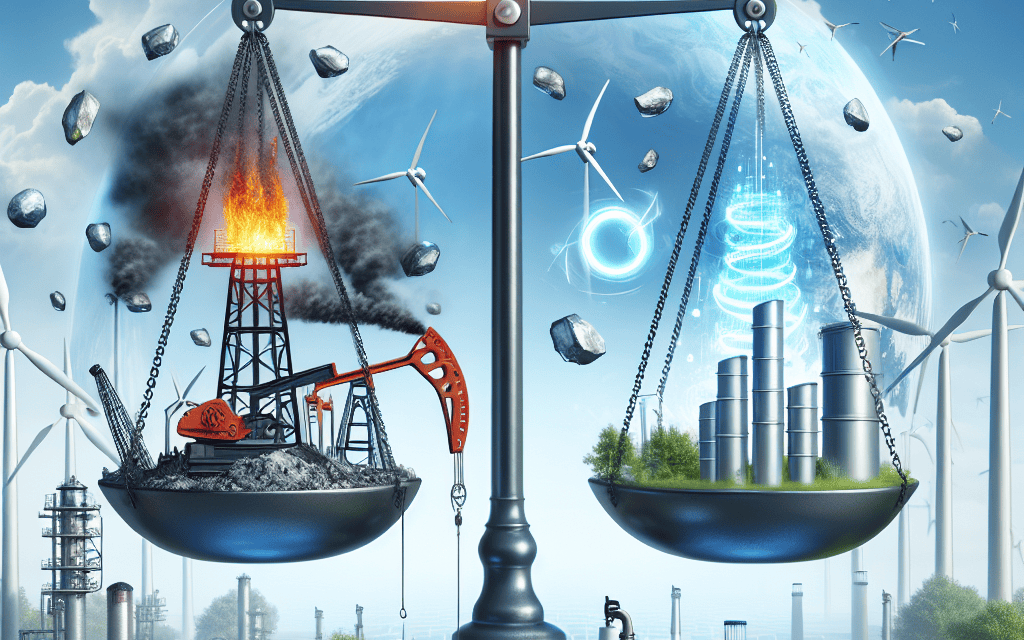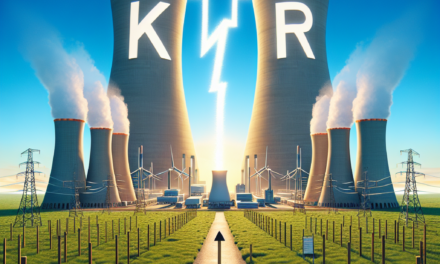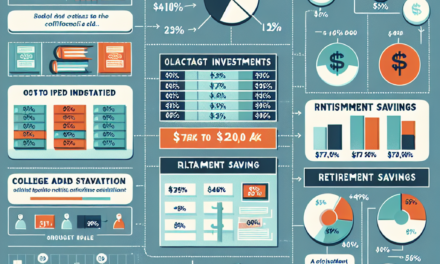“Empowering the Future: Affordable Energy Beyond Oil and Gas”
Introduction
The International Energy Agency (IEA) has projected a transformative shift in the global energy landscape, forecasting a future where the world is set to benefit from more affordable energy as it transitions away from traditional oil and gas sources. This shift is driven by a combination of technological advancements, policy changes, and increased investment in renewable energy sources such as wind, solar, and hydropower. The IEA’s analysis suggests that as countries strive to meet climate goals and reduce carbon emissions, the reliance on fossil fuels will diminish, leading to a more diversified and resilient energy system. This transition is expected to not only stabilize energy prices but also enhance energy security and accessibility worldwide, marking a significant step towards a sustainable energy future.
Transitioning to Renewable Energy Sources
The global energy landscape is undergoing a significant transformation as the world increasingly shifts from traditional oil and gas sources to renewable energy. According to the International Energy Agency (IEA), this transition is poised to make energy more affordable in the long run. The IEA’s recent report highlights the potential for renewable energy to not only reduce costs but also to enhance energy security and mitigate environmental impacts. As countries strive to meet their climate goals, the adoption of renewable energy sources such as wind, solar, and hydropower is accelerating at an unprecedented pace.
One of the primary drivers of this shift is the declining cost of renewable energy technologies. Over the past decade, the cost of solar photovoltaic systems and wind turbines has plummeted, making them increasingly competitive with fossil fuels. This trend is expected to continue as technological advancements and economies of scale further drive down prices. Consequently, countries are investing heavily in renewable infrastructure, recognizing the long-term economic benefits of reducing reliance on volatile oil and gas markets.
Moreover, the transition to renewable energy is not only economically advantageous but also crucial for environmental sustainability. The burning of fossil fuels is a major contributor to greenhouse gas emissions, which are driving climate change. By shifting to cleaner energy sources, nations can significantly reduce their carbon footprints and contribute to global efforts to limit temperature rise. This environmental imperative is prompting governments to implement policies and incentives that encourage the adoption of renewables, further accelerating the transition.
In addition to cost and environmental benefits, renewable energy offers enhanced energy security. Unlike oil and gas, which are often subject to geopolitical tensions and supply disruptions, renewable resources are abundant and widely distributed. This decentralization reduces the risk of energy shortages and price spikes, providing a more stable and reliable energy supply. As a result, countries are increasingly prioritizing energy independence by investing in domestic renewable energy projects.
However, the transition to renewable energy is not without its challenges. Integrating large amounts of variable renewable energy into existing power grids requires significant infrastructure upgrades and technological innovations. Energy storage solutions, such as batteries, are essential to ensure a consistent power supply when the sun isn’t shining or the wind isn’t blowing. Additionally, transitioning away from fossil fuels necessitates a comprehensive approach that includes retraining workers and supporting communities dependent on the oil and gas industry.
Despite these challenges, the momentum behind renewable energy is undeniable. The IEA’s report underscores the importance of international cooperation and investment in research and development to overcome barriers and accelerate the transition. By working together, countries can share best practices, pool resources, and drive innovation in renewable technologies.
In conclusion, the shift from oil and gas to renewable energy is set to make energy more affordable, secure, and sustainable. As the world embraces this transition, the benefits extend beyond economic savings to include environmental protection and enhanced energy security. While challenges remain, the commitment to renewable energy is clear, and the potential for a cleaner, more sustainable future is within reach. The IEA’s findings serve as a reminder of the critical role that renewable energy will play in shaping the global energy landscape in the years to come.
Impact of Cheaper Energy on Global Economies
The International Energy Agency (IEA) has recently projected a significant shift in the global energy landscape, suggesting that the world is poised to benefit from cheaper energy as it transitions away from traditional oil and gas sources. This anticipated shift is expected to have profound implications for global economies, potentially reshaping economic structures and influencing various sectors. As countries increasingly invest in renewable energy sources such as wind, solar, and hydropower, the cost of energy production is expected to decrease. This transition is driven by technological advancements and economies of scale, which have made renewable energy more competitive compared to fossil fuels. Consequently, the reduction in energy costs is likely to stimulate economic growth by lowering production costs for businesses and reducing energy expenses for consumers.
Moreover, the shift towards cheaper energy is anticipated to enhance energy security for many nations. By diversifying energy sources and reducing reliance on imported oil and gas, countries can mitigate the risks associated with volatile fossil fuel markets. This increased energy independence can lead to more stable economic environments, fostering investment and innovation. Additionally, the environmental benefits of transitioning to cleaner energy sources cannot be overlooked. As countries move away from carbon-intensive fuels, there is potential for significant reductions in greenhouse gas emissions, contributing to global efforts to combat climate change. This environmental progress can also have economic benefits, as it may reduce the costs associated with climate-related disasters and health issues caused by pollution.
Furthermore, the transition to cheaper energy is expected to create new economic opportunities and jobs in the renewable energy sector. As demand for renewable technologies grows, there will be an increased need for skilled workers in areas such as manufacturing, installation, and maintenance of renewable energy systems. This shift could lead to job creation and economic revitalization in regions that invest in renewable energy infrastructure. However, it is important to acknowledge the challenges that may arise during this transition. Traditional energy sectors, particularly those reliant on oil and gas, may face economic disruptions as demand for fossil fuels declines. This could lead to job losses and economic instability in regions heavily dependent on these industries. Therefore, it is crucial for policymakers to implement strategies that support workers and communities affected by the transition, ensuring a just and equitable shift to a low-carbon economy.
In addition, the global nature of the energy transition means that international cooperation will be essential. Countries will need to collaborate on technology development, policy frameworks, and financial mechanisms to ensure a smooth transition to cheaper and cleaner energy. This cooperation can also help to address disparities between developed and developing nations, ensuring that all countries can benefit from the economic opportunities presented by the energy transition. In conclusion, the IEA’s projection of a shift towards cheaper energy as the world moves away from oil and gas presents both opportunities and challenges for global economies. While the transition promises economic growth, enhanced energy security, and environmental benefits, it also requires careful management to address potential disruptions and ensure an equitable transition. By embracing this shift and fostering international collaboration, countries can harness the potential of cheaper energy to drive sustainable economic development and create a more resilient global economy.
Innovations in Energy Storage Technologies
The global energy landscape is undergoing a transformative shift, as highlighted by the International Energy Agency (IEA) in its recent report. This transition from traditional oil and gas to more sustainable energy sources is not only expected to reduce costs but also to significantly alter the dynamics of energy production and consumption. Central to this evolution is the advancement of energy storage technologies, which are poised to play a pivotal role in facilitating the widespread adoption of renewable energy.
Energy storage technologies have long been recognized as a critical component in the transition to a more sustainable energy system. They address the intermittent nature of renewable energy sources such as solar and wind, which do not produce electricity consistently throughout the day. By storing excess energy generated during peak production times, these technologies ensure a steady supply of electricity even when production is low. This capability is essential for maintaining grid stability and reliability, which are crucial for the widespread integration of renewables.
Recent innovations in energy storage have focused on improving efficiency, reducing costs, and increasing the lifespan of storage systems. Lithium-ion batteries, which have dominated the market for years, are now being complemented by emerging technologies such as solid-state batteries, flow batteries, and advanced supercapacitors. These new technologies offer promising improvements in energy density, safety, and environmental impact. For instance, solid-state batteries eliminate the flammable liquid electrolyte found in traditional lithium-ion batteries, enhancing safety and potentially offering higher energy densities.
Moreover, flow batteries, which store energy in liquid electrolytes contained in external tanks, provide the advantage of scalability and long-duration storage. This makes them particularly suitable for large-scale applications, such as grid storage, where they can help balance supply and demand over extended periods. Additionally, advancements in supercapacitors, known for their rapid charge and discharge capabilities, are opening new possibilities for applications requiring quick bursts of energy.
The economic implications of these advancements are significant. As energy storage technologies become more efficient and less expensive, the overall cost of renewable energy systems is expected to decrease. This reduction in cost will make renewable energy more competitive with fossil fuels, accelerating the shift away from oil and gas. Furthermore, the ability to store energy effectively will enable countries to harness their renewable resources more fully, reducing dependence on imported fossil fuels and enhancing energy security.
In addition to technological advancements, policy support and investment are crucial for the continued development and deployment of energy storage solutions. Governments around the world are recognizing the importance of energy storage in achieving climate goals and are implementing policies to support research, development, and deployment. Incentives such as tax credits, grants, and subsidies are being introduced to encourage investment in energy storage projects, further driving down costs and spurring innovation.
In conclusion, the shift from oil and gas to renewable energy sources, as highlighted by the IEA, is set to bring about cheaper and more sustainable energy solutions. Innovations in energy storage technologies are at the forefront of this transition, offering the potential to overcome the challenges associated with renewable energy integration. As these technologies continue to evolve and mature, they will play an increasingly vital role in shaping a cleaner, more resilient energy future. The synergy between technological innovation, policy support, and market dynamics will be key to realizing the full potential of this energy transformation.
Policy Changes Driving the Energy Shift

The global energy landscape is undergoing a transformative shift, driven by policy changes that are steering the world away from traditional oil and gas dependency towards more sustainable and cost-effective energy sources. According to the International Energy Agency (IEA), this transition is poised to make energy more affordable on a global scale. The IEA’s recent report highlights how strategic policy interventions are catalyzing this shift, with governments around the world implementing measures to reduce carbon emissions and promote renewable energy adoption.
One of the primary drivers of this transition is the increasing commitment of countries to meet international climate goals, such as those outlined in the Paris Agreement. These commitments have led to the implementation of policies that incentivize the development and deployment of renewable energy technologies. For instance, subsidies for solar and wind energy projects, along with tax incentives for clean energy investments, are making renewables more competitive with fossil fuels. As a result, the cost of renewable energy has been declining steadily, making it an attractive option for both consumers and investors.
Moreover, technological advancements are playing a crucial role in accelerating the shift from oil and gas. Innovations in energy storage, grid management, and energy efficiency are enhancing the reliability and integration of renewable energy sources into existing energy systems. These advancements are not only reducing the costs associated with renewable energy but also addressing concerns about intermittency and reliability, which have historically been barriers to widespread adoption.
In addition to technological progress, the global financial sector is increasingly aligning itself with sustainable energy initiatives. Financial institutions are recognizing the long-term risks associated with fossil fuel investments and are shifting their portfolios towards renewable energy projects. This shift is being facilitated by policy frameworks that encourage green financing and sustainable investment practices. Consequently, the flow of capital into renewable energy is increasing, further driving down costs and accelerating the transition.
Furthermore, the geopolitical landscape is also influencing the energy shift. As countries seek to enhance their energy security and reduce reliance on imported fossil fuels, there is a growing emphasis on developing domestic renewable energy resources. This shift is particularly evident in regions that have historically been dependent on oil and gas imports. By investing in local renewable energy infrastructure, these countries are not only reducing their vulnerability to global energy market fluctuations but also creating new economic opportunities and jobs in the renewable energy sector.
While the transition to cheaper and cleaner energy is gaining momentum, it is not without challenges. Policymakers must navigate complex issues such as ensuring a just transition for workers in traditional energy sectors and addressing the infrastructural needs of emerging energy systems. However, the IEA report underscores that with continued policy support and international cooperation, these challenges can be effectively managed.
In conclusion, the world is on the cusp of a significant energy transformation, driven by policy changes that are facilitating a shift from oil and gas to more sustainable energy sources. This transition promises not only to make energy more affordable but also to contribute to global efforts to combat climate change. As countries continue to implement and refine policies that support renewable energy, the vision of a cleaner, more sustainable, and economically viable energy future becomes increasingly attainable.
The Role of Electric Vehicles in Reducing Oil Dependence
The global energy landscape is undergoing a transformative shift, as highlighted by the International Energy Agency (IEA) in its recent report. Central to this transformation is the increasing adoption of electric vehicles (EVs), which play a pivotal role in reducing the world’s dependence on oil and gas. As nations strive to meet climate goals and reduce carbon emissions, the transition from traditional fossil fuels to cleaner energy sources is becoming more pronounced. This shift is not only expected to lead to cheaper energy but also to reshape the geopolitical dynamics associated with oil and gas dependency.
Electric vehicles are at the forefront of this energy transition. Their rise in popularity is driven by several factors, including technological advancements, government incentives, and growing environmental awareness among consumers. As battery technology improves, EVs are becoming more affordable and accessible to a broader audience. This, in turn, is leading to a significant reduction in the demand for oil, traditionally used to fuel internal combustion engine vehicles. Consequently, the transportation sector, which has long been a major consumer of oil, is witnessing a paradigm shift.
Moreover, governments around the world are implementing policies to accelerate the adoption of electric vehicles. These policies include subsidies for EV purchases, investments in charging infrastructure, and stringent emissions regulations for conventional vehicles. Such measures are designed to create a conducive environment for the growth of the EV market, thereby reducing oil consumption. As a result, countries that have historically relied on oil imports are finding themselves less vulnerable to fluctuations in oil prices and supply disruptions.
In addition to reducing oil dependence, the shift towards electric vehicles is expected to have a profound impact on the global energy market. As the demand for oil decreases, the IEA predicts that energy prices will become more stable and potentially lower. This is because the volatility often associated with oil markets, driven by geopolitical tensions and supply constraints, will be mitigated by a diversified energy mix that includes renewables and electricity. Consequently, consumers and industries alike stand to benefit from more predictable and affordable energy costs.
Furthermore, the environmental benefits of electric vehicles cannot be overstated. By reducing the reliance on oil, EVs contribute to a decrease in greenhouse gas emissions, which are a major driver of climate change. This aligns with the global push towards achieving net-zero emissions by mid-century, a goal that is becoming increasingly urgent in the face of escalating climate impacts. The transition to electric vehicles, therefore, represents a critical step in the broader effort to create a sustainable and resilient energy future.
In conclusion, the role of electric vehicles in reducing oil dependence is a key component of the ongoing energy transition. As highlighted by the IEA, this shift is poised to deliver not only environmental benefits but also economic advantages in the form of cheaper and more stable energy. As the world continues to embrace cleaner technologies, the momentum behind electric vehicles is likely to accelerate, paving the way for a future less reliant on oil and more focused on sustainable energy solutions. This transition, while challenging, offers a promising pathway towards a more secure and environmentally friendly global energy system.
Challenges in Phasing Out Fossil Fuels
The global energy landscape is undergoing a significant transformation as the world increasingly shifts away from traditional fossil fuels like oil and gas towards more sustainable energy sources. According to the International Energy Agency (IEA), this transition is expected to lead to cheaper energy in the long run. However, the path to achieving this goal is fraught with challenges that need to be addressed to ensure a smooth and effective transition.
One of the primary challenges in phasing out fossil fuels is the existing infrastructure that heavily relies on oil and gas. Many countries have invested billions of dollars in developing and maintaining infrastructure that supports the extraction, refinement, and distribution of these resources. Transitioning to renewable energy sources such as wind, solar, and hydropower requires substantial investment in new infrastructure, which can be a daunting task for both developed and developing nations. This shift necessitates not only financial resources but also political will and public support to reallocate funds and prioritize sustainable energy projects.
Moreover, the economic implications of moving away from fossil fuels cannot be overlooked. The oil and gas industry is a significant source of employment and revenue for many countries. As the world moves towards cleaner energy, there is a risk of job losses in these traditional sectors. To mitigate this, there is a pressing need for policies that support retraining and reskilling workers to transition into the renewable energy sector. This requires collaboration between governments, industry leaders, and educational institutions to develop programs that equip workers with the necessary skills for new opportunities in the evolving energy landscape.
In addition to economic challenges, there are also technical hurdles to overcome. Renewable energy sources are inherently variable and dependent on factors such as weather and geographic location. This variability poses a challenge for ensuring a stable and reliable energy supply. To address this, advancements in energy storage technologies, such as batteries and other innovative solutions, are crucial. These technologies can store excess energy generated during peak production times and release it when demand is high, thus ensuring a consistent energy supply.
Furthermore, the transition to renewable energy must be equitable and inclusive. Developing countries, which often lack the financial resources and technological capabilities of their developed counterparts, may face additional obstacles in adopting sustainable energy solutions. International cooperation and support are essential to ensure that these nations are not left behind in the global energy transition. This includes providing financial assistance, technology transfer, and capacity-building initiatives to help developing countries harness their renewable energy potential.
Despite these challenges, the benefits of transitioning to a cleaner energy future are substantial. Reducing reliance on fossil fuels can lead to significant reductions in greenhouse gas emissions, thereby mitigating the impacts of climate change. Additionally, renewable energy sources are becoming increasingly cost-competitive with traditional fossil fuels, offering the potential for more affordable energy in the long term. This shift not only promises environmental benefits but also economic opportunities, as the renewable energy sector continues to grow and innovate.
In conclusion, while the transition from oil and gas to renewable energy presents numerous challenges, it also offers a pathway to a more sustainable and economically viable energy future. By addressing the economic, technical, and social hurdles associated with this shift, the world can move towards a cleaner, more equitable energy system that benefits all. The IEA’s optimistic outlook on cheaper energy underscores the importance of continued investment, innovation, and collaboration in overcoming the challenges of phasing out fossil fuels.
Investment Opportunities in the Green Energy Sector
The global energy landscape is undergoing a transformative shift, as highlighted by the International Energy Agency (IEA) in its recent report. This transition from traditional oil and gas to renewable energy sources is not only set to make energy more affordable but also presents a plethora of investment opportunities in the burgeoning green energy sector. As the world grapples with the pressing need to address climate change, the pivot towards sustainable energy solutions is becoming increasingly imperative. Consequently, investors are keenly eyeing the green energy sector, recognizing its potential for substantial returns and long-term growth.
The IEA’s report underscores the declining costs associated with renewable energy technologies, such as solar and wind power. These advancements have been driven by technological innovations, economies of scale, and increased competition within the sector. As a result, the cost of generating electricity from renewable sources has plummeted, making it more competitive with, and often cheaper than, fossil fuels. This trend is expected to continue, further incentivizing investments in green energy projects. Moreover, governments worldwide are implementing policies and incentives to accelerate the transition to clean energy, thereby creating a favorable environment for investors.
In addition to the economic benefits, the shift towards renewable energy is also driven by environmental considerations. The reduction of greenhouse gas emissions is a critical goal for many nations, and investing in green energy is a tangible way to achieve this. As countries commit to ambitious targets for reducing carbon emissions, the demand for clean energy solutions is set to rise. This presents a unique opportunity for investors to align their portfolios with sustainable practices while capitalizing on the growth potential of the sector.
Furthermore, the green energy sector is not limited to traditional renewable sources like solar and wind. Emerging technologies such as energy storage, hydrogen fuel cells, and electric vehicles are gaining traction and attracting significant investment. Energy storage, in particular, is crucial for addressing the intermittency of renewable energy sources, ensuring a stable and reliable power supply. As these technologies mature, they offer additional avenues for investment, promising both innovation and profitability.
Transitioning from oil and gas to renewable energy also has implications for job creation and economic development. The green energy sector is labor-intensive, requiring a skilled workforce for the installation, maintenance, and operation of renewable energy systems. This shift is expected to generate millions of jobs globally, contributing to economic growth and stability. For investors, this translates into a robust and dynamic market with diverse opportunities across various segments of the industry.
In conclusion, the IEA’s report highlights a pivotal moment in the global energy landscape, with the transition from oil and gas to renewable energy offering significant investment opportunities. As the world moves towards a more sustainable future, the green energy sector stands out as a promising area for investors seeking to capitalize on the economic, environmental, and social benefits of this shift. By embracing the potential of renewable energy, investors can not only achieve financial gains but also contribute to a more sustainable and resilient global economy.
Q&A
1. **What is the main focus of the IEA report?**
The report focuses on the global shift from oil and gas to renewable energy sources, which is expected to lead to cheaper energy in the future.
2. **What are the key drivers for the shift from oil and gas?**
Key drivers include advancements in renewable energy technologies, policy support for clean energy, and increasing concerns about climate change.
3. **How does the IEA view the future of energy prices?**
The IEA predicts that energy prices will decrease as the world transitions to more sustainable and cost-effective energy sources.
4. **What role do governments play in this energy transition?**
Governments play a crucial role by implementing policies and regulations that support renewable energy development and by investing in clean energy infrastructure.
5. **What impact will this shift have on oil and gas industries?**
The shift is likely to reduce demand for oil and gas, potentially leading to lower revenues and a need for these industries to adapt by diversifying their energy portfolios.
6. **What are the expected benefits of transitioning to renewable energy?**
Benefits include reduced greenhouse gas emissions, improved air quality, enhanced energy security, and economic opportunities in the renewable energy sector.
7. **What challenges does the transition to renewable energy face?**
Challenges include the need for significant investment, technological advancements, grid infrastructure upgrades, and managing the socio-economic impacts on communities reliant on fossil fuels.
Conclusion
The International Energy Agency (IEA) reports that the global energy landscape is poised for a significant transformation as the world shifts away from oil and gas towards more sustainable and cost-effective energy sources. This transition is driven by technological advancements, policy changes, and increased investment in renewable energy, which are collectively reducing the costs associated with clean energy production. As a result, the global energy market is expected to become more diversified and resilient, with renewables playing a central role in meeting future energy demands. This shift not only promises to lower energy costs but also supports global efforts to combat climate change by reducing carbon emissions.





